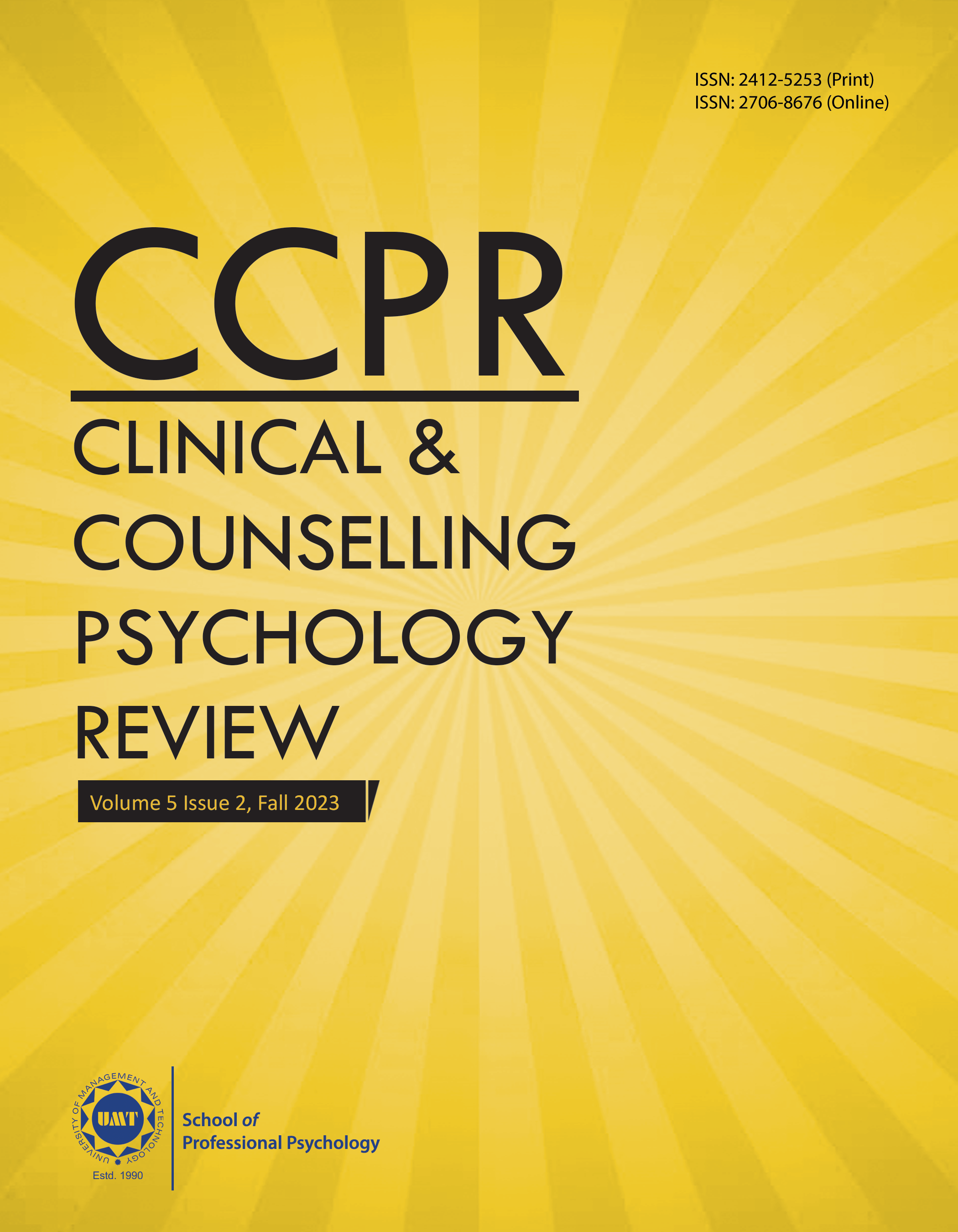Hypersensitive Narcissism, Social Media Usage, and Selfitis Behaviour among University Students: Mediating Role of Self-Esteem
Abstract
 Abstract Views: 0
Abstract Views: 0
The current study aimed to examine the relationship between hypersensitive narcissism, social media usage, and selfitis behaviour along with the mediating role of self-esteem among university students in Pakistan. Correlational research design and purposive sampling technique were used in the study. The sample comprised (N=200) university students with a mean age of 21.45 years (SD=2.42). Both men (n=100) and women (n=100) participants were included in the study. Standard instruments such as the Hypersensitive Narcissism Scale (HSNS), Selfitis Behaviour Scale (SBS), Social Media Affinity Scale (SMAS), and Rosenberg Self-Esteem Scale (RSES) were used to collect the data. The results indicated that hypersensitive narcissism, social media usage, and selfitis behaviour have a significant positive correlation, while they exhibit a non-significant correlation with self-esteem. The findings also revealed that hypersensitive narcissism and social media usage positively predict selfitis behaviour. It was also determined that hypersensitive narcissism, social media usage, selfitis behaviour, and self-esteem have the same impact on both genders. Self-esteem was taken as a mediator but the results showed that it did not mediate between these variables. The study may assist future educators, mental health professionals, and policymakers in recognizing and addressing such risk factors to promote a healthier academic and social environment. The study may further contribute to discussions related to digital well-being and the need for guidelines to ensure that social media platforms are used in ways that enhance rather than diminish the self-esteem of university students.
Downloads
References
Andreassen, C. S., Pallesen, S., & Griffiths, M. D. (2017). The relationship between addictive use of social media, narcissism, and self-esteem: Findings from a large national survey. Addictive Behavior, 64, 287–293. https://doi.org/10.1016/j.addbeh.2016.03.006
Arpacia, I., Yalçınb, S. B., Baloğluc, M., & Kesicib, S. (2018). The moderating effect of gender in the relationship between narcissism and selfie-posting behavior. Personality and Individual Differences, 134, 71–74.
Asgher, S., Gohar, I., & Latif, F. (2022). Social media and narcissism: Cultivation analysis of association, elements and reasons. Pakistan Languages and Humanities Review, 6(4), 129–138. https://doi.org/10.47205/plhr.2022(6-IV)13
Balakrishnan, J., & Griffiths, M. D. (2018) An exploratory study of "selfitis" and the development of the Selfitis Behavior Scale. International Journal of Mental Health and Addiction, 16(3), 722–736. https://doi.org/10.1007/s11469-017-9844-x
Bansal, A., Garg, C., Pakhare, A., & Gupta, S. (2018). Selfies: A boon or bane? Journal of Family Medicine and Primary Care, 7(4), 828–831. https://doi.org/10.4103/jfmpc.jfmpc_109_18
Barry, C. T., Reiter, S. R., Anderson, A. C., Schoessler, M. L., & Sidoti, C. L. (2019). “Let me take another selfie”: Further examination of the relation between narcissism, self-perception, and Instagram posts. Psychology of Popular Media Culture, 8(1), 22–33. https://doi.org/10.1037/ppm0000155
Boursier, V., Gioia, F., & Griffiths, M. D. (2020). Selfie-engagement on social media: Pathological narcissism, positive expectation, and body objectification - Which is more influential? Addictive Behaviors Reports, 11, Article e100263. https://doi.org/10.1016/j.abrep.2020.100263
Boursier, V., & Manna, V. (2018). Selfie expectancies among adolescents: construction and validation of an instrument to assess expectancies toward selfies among boys and girls. Frontiers in Psychology, 9, Article e839. https://doi.org/10.3389/fpsyg.2018.00839
Brailovskaia, J., & Bierhoff, H.-W. (2016). Cross-cultural narcissism on Facebook: Relationship between selfpresentation, social interaction and the open and covert narcissism on a social networking site in Germany and Russia. Computers in Human Behavior, 55(Part A), 251–257. https://doi.org/10.1016/j.chb.2015.09.018
Buffardi, L. E., & Campbell, W. K. (2008). Narcissism and social networking web sites. Personality and Social Psychology Bulletin, 34(10), 1303–1314. https://doi.org/10.1177/0146167208320061
Casale, S., Fioravanti, G., & Rugai, L. (2016). Grandiose and vulnerable narcissism: Who is at higher risk for social networking addiction? Cyberpsychology, Behavior and Social Networking, 19(8), 510–515. http://dx.doi.org/10.1089/cyber.2016.0189
Chen, S., English, T., & Peng, K. (2006). Self-verification and contextualized self-views. Personality and Social Psychology Bulletin, 32(7), 930–942. https://doi.org/10.1177/0146167206287539
Cohen, D. (2016, January 6). Selfies, narcissism and social media (Infographic). Adweek. https://www.adweek.com/performance-marketing/rawhide-selfies-infographic/
Cooley, C. H. (1902). Human nature and the social order. Scribner's Sons.
Coulthard, N. & Ogden, J. (2018). The impact of posting selfies and gaining feedback (‘likes’) on the psychological wellbeing of 16–25 year olds: An experimental study. Cyberpsychology: Journal of Psychosocial Research on Cyberspace, 12(2), Article e4. https://doi.org/10.5817/CP2018-2-4
Davenport, S. W., Bergman, S. M., Bergman, J. Z., & Fearrington, M. E. (2014). Twitter versus Facebook: Exploring the role of narcissism in the motives and usage of different social media platforms. Computers in Human Behavior, 32, 212–220. https://doi.org/10.1016/j.chb.2013.12.011
Dhillon, S. K. (2019). Narcissism as cause of selfitis behaviour and low self-esteem: Gender and developmental differences. IAHRW International Journal of Social Sciences Review, 7(6-I).
Di Pierro, R., Mattavelli, S., & Gallucci, M. (2016). Narcissistic traits and explicit self-esteem: The moderating role of implicit self-view. Frontiers in Psychology, 7, Article e1815. https://doi.org/10.3389/fpsyg.2016.01815
Eftekhar, A., Fullwood, C., & Morris, N. (2014). Capturing personality from Facebook photos and photo-related activities: How much exposure do you need? Computers in Human Behavior, 37, 162–170. https://doi.org/10.1016/j.chb.2014.04.048
Freud, S. (1914). On narcissism: An introduction. In J. Strachey (Ed.) The standard edition of the complete psychological works of Sigmund Freud (Vol. 14, pp. 1914–1916). Hogarth Press.
Fox, J., & Rooney, M. C. (2015). The dark triad and trait self-objectification as predictors of men’s use and self-presentation behaviors on social networking sites. Personality and Individual Differences, 76, 161–165. https://doi.org/10.1016/j.paid.2014.12.017
Gerlich, R. N., Browning, L., & Westermann, L. (2010). The Social Media Affinity Scale: Implications for education. Contemporary Issues in Education Research, 3(11), 35–42.
Guo, M., Liu, R. -D., Ding, Y., Hu, B., Zhen, R., Liu, Y., & Jiang, R. (2018). How are extraversion, exhibitionism, and gender associated with posting selfies on WeChat friends’ circle in Chinese teenagers? Personality and Individual Differences, 127, 114–116. http://dx.doi.org/10.1016/j.paid.2018.01.042
Hendin, H. M., & Cheek, J. M. (1997). Assessing hypersensitive narcissism: A reexamination of Murray's Narcism Scale. Journal of Research in Personality, 31(4), 588–599. https://doi.org/10.1006/jrpe.1997.2204
Hines, N. (2016, February 3). Selfie trend put into perspective: The total number of selfie-related deaths since 2014. AllThatsInteresting.com. Retrieved May 26, 2023, from https://allthatsinteresting.com/selfie-deaths
Indvik, L. (2012, July 10). Social media fuels low self-esteem, anxiety. Stuff. https://www.stuff.co.nz/technology/digital-living/7251434/Social-media-fuels-low-self-esteem-anxiety
Joinson, A. N. (2004). Self-esteem, interpersonal risk, and preference for e-mail to face-to-face communication. Cyberpsychology & Behavior: The Impact of the Internet, Multimedia and Virtual Reality on Behavior and Society, 7(4), 472–478. https://doi.org/10.1089/cpb.2004.7.472
Kapidzic, S. (2013). Narcissism as a predictor of motivations behind Facebook profile picture selection. Cyberpsychology, Behavior, and Social Networking, 16(1), 14–19. https://doi.org/10.1089/cyber.2012.0143
Kaur, S., & Vig, D. (2016). Selfie and mental health issues: An overview. Indian Journal of Health and Wellbeing, 7(12), 1149–1152.
Kernberg, O. (1975). Borderline conditions and pathological narcissism. Jason Aronson.
Kohut, H. (1977). The restoration of the self. International Universities Press.
Lee, W.K. (2017). The Relationship between narcissism and problematic social networking sites (SNS) Use: Mediating role of attachment instability. International Journal of Emergency Mental Health and Human Resilience, 19(3), 1–5.
Lin, CY., Lin, CK., Imani, V., Griffiths, M. D., & Pakpour, A. H. (2020). Evaluation of the Selfitis Behavior Scale Across two Persian-speaking countries, Iran and Afghanistan: Advanced psychometric testing in a large-scale sample. International Journal of Mental Health and Addiction, 18, 222–235. https://doi.org/10.1007/s11469-019-00124-y
Liu, C., & Ma, J. (2018). Development and validation of the Chinese Social Media Addiction Scale. Personality and Individual Differences, 134, 55–59. https://doi.org/10.1016/j.paid.2018.05.046
Malik, N. I., Zafar, J., & Saleemi, A. (2020). Narcissism and self esteem as predictors of selfitis among youth. Rawal Medical Journal, 45(2), 331–333.
March, E., & McBean, T. (2018). New evidence shows self-esteem moderates the relationship between narcissism and selfies. Personality and Individual Differences, 130, 107–111. https://doi.org/10.1016/j.paid.2018.03.053
McCain, J. L., & Campbell, W. K. (2018). Narcissism and social media use: A meta-analytic review. Psychology of Popular Media Culture, 7(3), 308–327. https://doi.org/10.1037/ppm0000137
McLean, S. A., Jarman, H. K., & Rodgers, R. F. (2019). How do "selfies" impact adolescents' well-being and body confidence? A narrative review. Psychology Research and Behavior Management, 12, 513–521. https://doi.org/10.2147/PRBM.S177834
Mehdizadeh, S. (2010). Self-presentation 2.0: Narcissism and self-esteem on Facebook. Cyberpsychology, Behavior, and Social Networking, 13(4), 357–364. https://doi.org/10.1089/cyber.2009.0257
Miller, J. D., Hoffman, B. J., Gaughan, E. T., Gentile, B., Maples, J., & Keith Campbell, W. (2011). Grandiose and vulnerable narcissism: A nomological network analysis. Journal of Personality, 79(5), 1013–1042. https://doi.org/10.1111/j.1467-6494.2010.00711.x
Moon, J. H., Lee, E., Lee, J.-A., Choi, T. R., & Sung, Y. (2016). The role of narcissism in self-promotion on Instagram. Personality and Individual Differences, 101, 22–25. https://doi.org/10.1016/j.paid.2016.05.042
Murray, H. A. (1938). Explorations in personality. Oxford University Press.
Oeldorf-Hirsch, A., & Sundar, S. S. (2016). social and technological motivations for online photo sharing. Journal of Broadcasting & Electronic Media, 60(4), 624–642. https://doi.org/10.1080/08838151.2016.1234478
Rosenberg, M. (1965). Society and the adolescent self- image. Princeton University Press.
Salafia, C., & Rimzhim, A. (2020). Motivation for selfie-posting mediates the relationship
between narcissism and empathy. The Journal of Social Media and Society, 9 (2), 353–380.
Senft, T., & Baym, N. K. (2015). What does the selfie say? Investigating a global phenomenon. International Journal of Communication, 9, 1588–1606.
Shin, Y., Kim, M., Im, C., & Chong, C. (2017). Selfie and self: the effect of selfies on self- esteem and social sensitivity. Personality and Individual Differences, 111,139–145. https://doi.org/10.1016/j.paid.2017.02.004
Singh, S., Farley, S. D., & Donahue, J. J. (2018). Grandiosity on display: Social media behaviors and dimensions of narcissism. Personality and Individual Differences, 134, 308–313. https://doi.org/10.1016/j.paid.2018.06.039
Swann, W. B. (1983). Self-verification: Bringing social reality into harmony with the self. In J. Suls, & A. G. Greenwald (Eds.), Social psychological perspectives on the self (Vol. 2, pp. 33-66). Lawrence Erlbaum.
Swann, W. B. (1987). Identity negotiation: Where two roads meet. Journal of Personality and Social Psychology, 53(6), 1038–1051. https://doi.org/10.1037/0022-3514.53.6.1038
Tobin, S. J., Vanman, E. J., Verreynne, M., & Saeri, A. K. (2015). Threats to belonging on Facebook: Lurking and ostracism. Social Influence, 10(1), 31–42. https://doi.org/10.1080/15534510.2014.893924
Valkenburg, M., Koutamanis, M., & Vossen, H.G. (2017). The concurrent and longitudinal relationship between adolescents’ use of social network sites and their social self-esteem. Computers in Human Behavior,76, 35–41. https://doi.org/10.1016/j.chb.2017.07.008
Van Der Heide, B., D'Angelo, J. D., & Schumaker, E. M. (2012). The effects of verbal versus photographic self-presentation on impression formation in Facebook. Journal of Communication, 62(1), 98–116. https://doi.org/10.1111/j.1460-2466.2011.01617.x
Veldhuis, J., Alleva, J. M., de Vaate, A. J. D. B., Keijer, M., & Konijn, E. A. (2020). Me, my selfie, and I: The relations between selfie behaviors, body image, self-objectification, and self-esteem in young women. Psychology of Popular Media, 9(1), 3-13. https://doi.org/10.1037/ppm0000206
Vincent, J. (2014, March 31). American Psychiatric Association makes it official: ‘Selfie’ a mental disorder. Adobo Chronicles. https://adobochronicles.com/2014/03/31/american-psychiatric-association-makes-it-official-selfie-a-mental-disorder/comment-page-3/
Wang, Y., Xie, X., Wang, X., Wang, P., Nie, J., & Lei, L. (2018). Narcissism and selfie-posting behavior: The mediating role of body satisfaction and the moderating role of attitude toward selfie-posting behavior. Current Psychology, 39(2), 1–8. https://link.springer.com/article/10.1007/s12144-018-9795-9
Zeigler-Hill, V., Clark, C. B., & Pickard, J. D. (2008). Narcissistic subtypes and contingent self-esteem: Do all narcissists base their self-esteem on the same domains? Journal of Personality, 76(4), 753–774. https://doi.org/10.1111/j.1467-6494.2008.00503.x








